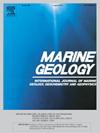A recently identified mass-transport deposit stack in the Guaymas Basin, Gulf of California (México), and its implication in the basin tectonics
IF 2.2
3区 地球科学
Q2 GEOSCIENCES, MULTIDISCIPLINARY
引用次数: 0
Abstract
A large mass transport deposit (MTD) stack has been identified in the Guaymas Basin using seventeen high-resolution seismic reflection profiles and sediment core analysis. Guaymas Basin is a young, marginal basin characterized by active seafloor spreading in the central Gulf of California, Mexico. The large stack includes five distinct MTD units of variable thickness, area, and volume, characterized by a predominantly transparent seismic reflection facies with small sections of laterally discontinuous reflectors and bumpy upper and erosional lower surfaces. Based on analysis of sediment cores from Site U1551A from International Ocean Discovery Program Expedition 385, we define MTD lithofacies and use sand provenance to infer that the MTD stack originated from the Yaqui Delta region of the Sonoran margin, transporting material to the south-west. We suggest that a combination of high sedimentation rates and active tectonics contributed to the MTD events. ‘Flower structures’ observed in margin-crossing profiles indicate that the MTD stack buried a part of the transform fault separating the Guaymas Basin and the continental Sonoran margin. Seismic reflection interpretations suggest that part of the MTD stack filled the southern graben applying local stresses that drove a change of the sediment surface expression of plate spreading in the sediment-filled basin. In response to the MTD emplacement and the southern graben fill, an additional northern seafloor graben in the Guaymas Basin developed. Our results contribute to the understanding of the interactions among high sedimentation rates, continental slope stability, and active tectonics; and the influence of those interactions on the surface expression of plate spreading in the Guaymas Basin.
最近在加利福尼亚湾瓜伊马斯盆地(msamuxico)发现的一个体运沉积堆及其在盆地构造中的意义
利用17条高分辨率地震反射剖面和沉积物岩心分析,在瓜伊马斯盆地发现了一个大型块体搬运沉积(MTD)叠层。瓜伊马斯盆地是墨西哥加利福尼亚湾中部一个年轻的边缘盆地,其特征是海底扩张活跃。大叠置包括5个不同的MTD单元,它们的厚度、面积和体积都是可变的,其特点是主要是透明的地震反射相,具有小截面的横向不连续反射体和凹凸不平的上表面和侵蚀的下表面。通过对国际海洋发现计划(385)U1551A站点沉积物岩心的分析,确定了MTD岩相,并利用砂物源推断出MTD叠层起源于索诺兰边缘雅基三角洲地区,向西南方向输送物质。我们认为,高沉积速率和活跃的构造活动共同促成了MTD事件。在边缘交叉剖面上观察到的“花状构造”表明,MTD叠层埋藏了分隔瓜伊马斯盆地和索诺兰大陆边缘的部分转换断层。地震反射解释表明,部分MTD叠置对南部地堑进行了填充物作用的局部应力作用,导致了沉积盆地内板块扩张的沉积面表达发生了变化。作为对MTD侵位和南部地堑填充物的响应,瓜伊马斯盆地北部又形成了一个海底地堑。我们的研究结果有助于理解高沉积速率、大陆斜坡稳定性和活动构造之间的相互作用;以及这些相互作用对瓜伊马斯盆地板块扩张地表表现的影响。
本文章由计算机程序翻译,如有差异,请以英文原文为准。
求助全文
约1分钟内获得全文
求助全文
来源期刊

Marine Geology
地学-地球科学综合
CiteScore
6.10
自引率
6.90%
发文量
175
审稿时长
21.9 weeks
期刊介绍:
Marine Geology is the premier international journal on marine geological processes in the broadest sense. We seek papers that are comprehensive, interdisciplinary and synthetic that will be lasting contributions to the field. Although most papers are based on regional studies, they must demonstrate new findings of international significance. We accept papers on subjects as diverse as seafloor hydrothermal systems, beach dynamics, early diagenesis, microbiological studies in sediments, palaeoclimate studies and geophysical studies of the seabed. We encourage papers that address emerging new fields, for example the influence of anthropogenic processes on coastal/marine geology and coastal/marine geoarchaeology. We insist that the papers are concerned with the marine realm and that they deal with geology: with rocks, sediments, and physical and chemical processes affecting them. Papers should address scientific hypotheses: highly descriptive data compilations or papers that deal only with marine management and risk assessment should be submitted to other journals. Papers on laboratory or modelling studies must demonstrate direct relevance to marine processes or deposits. The primary criteria for acceptance of papers is that the science is of high quality, novel, significant, and of broad international interest.
 求助内容:
求助内容: 应助结果提醒方式:
应助结果提醒方式:


